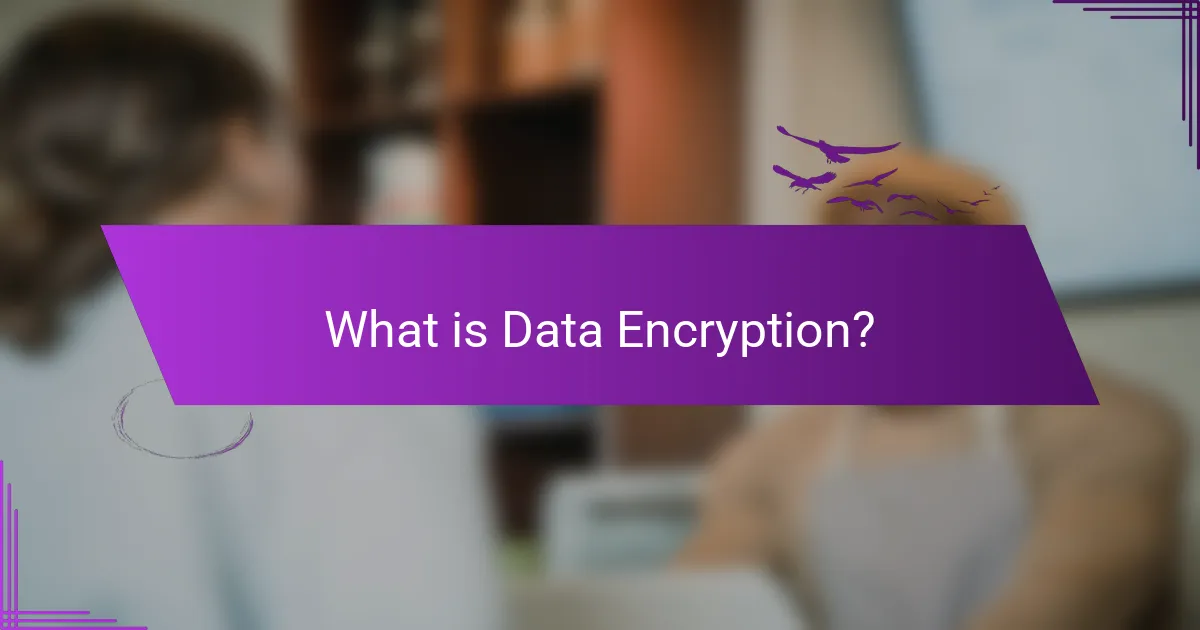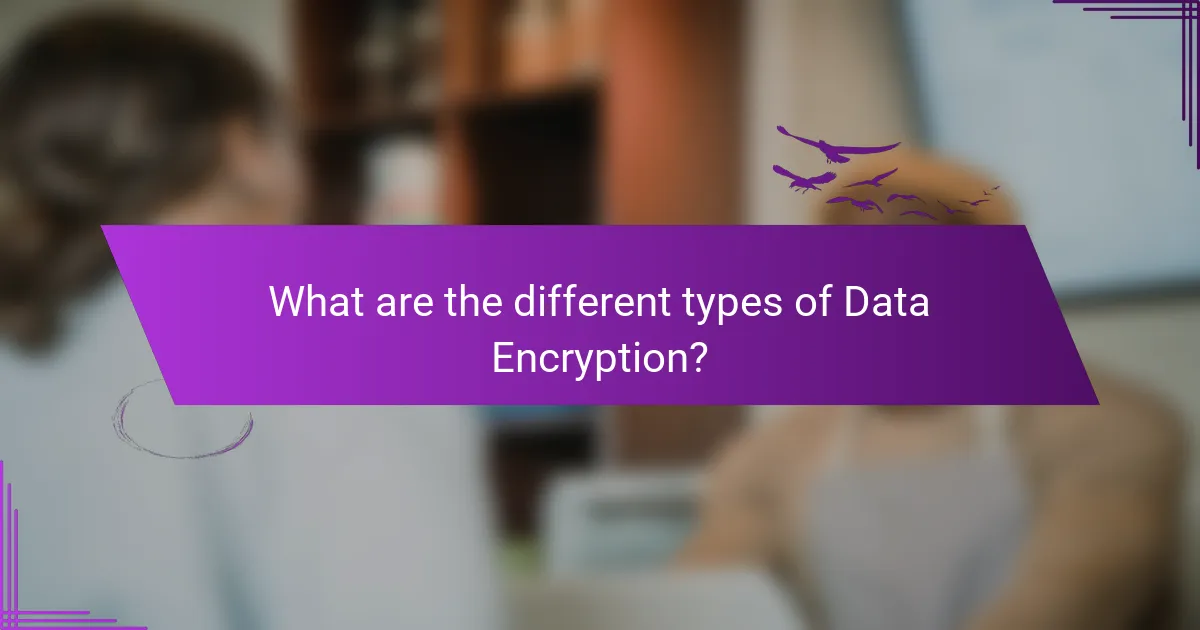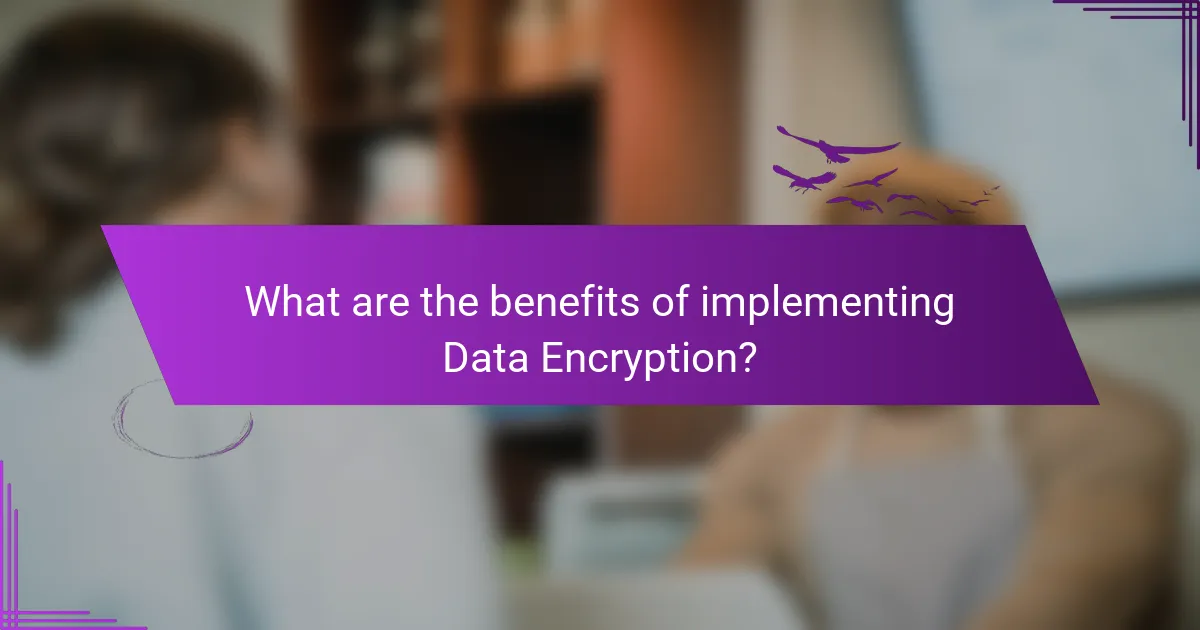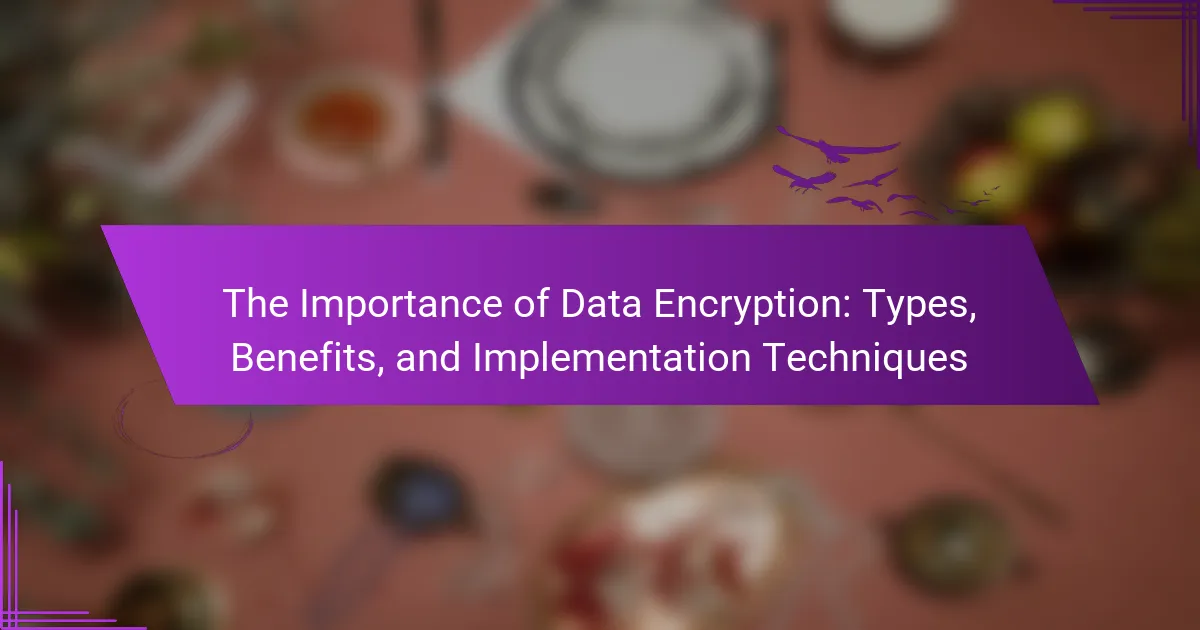
What is Data Encryption?
Data encryption is the process of converting information into a code to prevent unauthorized access. It secures data by transforming it into an unreadable format. Only individuals with the correct decryption key can access the original information. This technique is essential for protecting sensitive data, such as personal information and financial records. Data encryption is widely used in various applications, including online banking, secure communications, and data storage. According to the Cybersecurity & Infrastructure Security Agency, encryption is a critical component of data security strategies. It helps ensure data integrity and confidentiality in digital communications.
How does Data Encryption work?
Data encryption transforms readable data into an unreadable format. This process uses algorithms to encode information. Only authorized users with a decryption key can access the original data. Symmetric encryption uses the same key for both encryption and decryption. Asymmetric encryption employs a pair of keys: a public key for encryption and a private key for decryption. This ensures secure data transmission over networks. According to a report by the International Data Corporation, 70% of organizations use encryption to protect sensitive data. Data encryption is crucial for maintaining confidentiality and integrity in digital communications.
What are the key components of Data Encryption?
The key components of data encryption are algorithms, keys, and protocols. Algorithms define the method used to encrypt and decrypt data. Common algorithms include AES, RSA, and DES. Keys are unique strings of data used in the encryption process. A key’s length affects the security level; longer keys generally provide stronger encryption. Protocols govern how encryption is implemented and managed. Examples include SSL/TLS for secure web communications. These components work together to protect data from unauthorized access.
How do algorithms play a role in Data Encryption?
Algorithms are fundamental to data encryption as they define the mathematical procedures used to secure information. They convert plaintext into ciphertext, making data unreadable to unauthorized users. Common algorithms include AES, RSA, and DES. Each algorithm employs unique methods for encrypting and decrypting data. For example, AES uses symmetric key encryption, while RSA utilizes asymmetric key encryption. The strength of encryption relies on the complexity of the algorithm and the length of the key. Strong algorithms resist brute-force attacks, ensuring data confidentiality. According to the National Institute of Standards and Technology (NIST), AES is widely regarded as a secure standard for encrypting sensitive data.
Why is Data Encryption important in today’s digital landscape?
Data encryption is crucial in today’s digital landscape to protect sensitive information from unauthorized access. With the increase in cyber threats, data encryption ensures that even if data is intercepted, it remains unreadable without the decryption key. According to a report by Cybersecurity Ventures, cybercrime is projected to cost the world $10.5 trillion annually by 2025. This statistic underscores the necessity of encryption as a defense mechanism against data breaches. Additionally, regulations like GDPR mandate data protection measures, making encryption essential for compliance. By encrypting data, organizations also build trust with customers, assuring them that their information is secure. Therefore, data encryption is a fundamental practice for safeguarding privacy and maintaining data integrity in the digital age.
What are the risks of not using Data Encryption?
Not using data encryption exposes sensitive information to unauthorized access. This can lead to data breaches, where personal or financial information is stolen. Without encryption, data in transit is vulnerable to interception by hackers. It increases the risk of identity theft, as attackers can misuse stolen data. Regulatory non-compliance may occur, resulting in legal penalties for organizations. Additionally, the loss of customer trust can significantly harm a business’s reputation. Studies show that 60% of small businesses close within six months of a cyber attack. Therefore, failing to encrypt data can have severe financial and operational consequences.
How does Data Encryption protect sensitive information?
Data encryption protects sensitive information by converting it into a coded format that is unreadable without a decryption key. This process ensures that only authorized users can access the original data. Encryption algorithms, such as AES (Advanced Encryption Standard), use complex mathematical functions to secure data. When information is encrypted, it becomes nearly impossible for unauthorized parties to decipher it. For example, a 256-bit key in AES provides over 1.1 x 10^77 possible combinations, making brute-force attacks impractical. Additionally, encryption helps maintain data integrity by detecting unauthorized alterations. This layer of security is essential for protecting personal, financial, and confidential business information.

What are the different types of Data Encryption?
There are several types of data encryption. The primary types include symmetric encryption and asymmetric encryption. Symmetric encryption uses the same key for both encryption and decryption. Examples of symmetric algorithms are AES and DES. Asymmetric encryption uses a pair of keys, one public and one private. RSA is a widely used asymmetric algorithm. Another type is hashing, which converts data into a fixed-size string of characters. Hashing is commonly used for data integrity checks. Each type serves different purposes in securing data.
What is symmetric encryption and how does it function?
Symmetric encryption is a type of encryption where the same key is used for both encryption and decryption. It functions by transforming plaintext into ciphertext using a secret key. This key must be kept confidential between the communicating parties. When the recipient receives the ciphertext, they use the same key to revert it back to plaintext. Algorithms like AES and DES exemplify symmetric encryption methods. These algorithms are efficient and fast, making them suitable for large data volumes. According to the National Institute of Standards and Technology, AES is widely adopted for its security and performance.
What are the advantages of symmetric encryption?
Symmetric encryption offers several advantages, primarily speed and efficiency. It uses the same key for both encryption and decryption, which simplifies the process. This method is faster than asymmetric encryption, making it suitable for large data volumes. Symmetric encryption also requires less computational power, which is beneficial for devices with limited resources. Additionally, it provides strong security when keys are kept secret. The simplicity of key management in symmetric encryption can lead to easier implementation in various applications. Overall, these advantages make symmetric encryption a practical choice for securing sensitive information.
In what scenarios is symmetric encryption most effective?
Symmetric encryption is most effective in scenarios requiring high-speed data processing and secure communication between trusted parties. It is particularly suitable for encrypting large amounts of data quickly due to its efficiency. Symmetric encryption uses the same key for both encryption and decryption, making it faster than asymmetric encryption methods. This method is ideal for encrypting data at rest, such as files on a disk or database entries. It is also effective for securing data in transit, like communication between two systems over a secure channel. In environments where key management is straightforward, symmetric encryption can be highly secure. For example, organizations often use symmetric encryption for internal communications and data storage, where the risk of key exposure is minimized.
What is asymmetric encryption and how does it differ from symmetric encryption?
Asymmetric encryption is a cryptographic method that uses a pair of keys: a public key and a private key. The public key encrypts data, while the private key decrypts it. This method allows secure communication without sharing the private key. In contrast, symmetric encryption uses a single key for both encryption and decryption. Both parties must share this key securely. Asymmetric encryption enhances security by eliminating the need to exchange secret keys. Symmetric encryption is faster and more efficient for large data sets. However, asymmetric encryption is more secure for key exchange and authentication. The difference lies in key management and security levels.
What are the key features of asymmetric encryption?
Asymmetric encryption uses a pair of keys: a public key and a private key. The public key encrypts data, while the private key decrypts it. This method enhances security by ensuring that only the holder of the private key can access the encrypted information. Asymmetric encryption facilitates secure communications over unsecured channels. It enables digital signatures, which verify the authenticity of messages. This encryption method is foundational for protocols like HTTPS and secure email. The RSA algorithm is a widely recognized example of asymmetric encryption. Asymmetric encryption is computationally intensive, making it slower than symmetric encryption.
When should asymmetric encryption be used?
Asymmetric encryption should be used when secure communication is necessary between parties who have not previously exchanged keys. It is particularly effective for transmitting sensitive information over unsecured networks. This method allows users to encrypt data with a public key, ensuring that only the intended recipient can decrypt it with their private key. Asymmetric encryption is also ideal for digital signatures, which authenticate the sender’s identity and ensure message integrity. Additionally, it is useful in scenarios requiring key exchange, such as establishing secure connections in protocols like SSL/TLS. The unique attribute of asymmetric encryption is its ability to facilitate secure communication without the need for a shared secret, making it essential in modern cybersecurity practices.

What are the benefits of implementing Data Encryption?
Data encryption provides enhanced security for sensitive information. It protects data from unauthorized access and cyber threats. Encryption converts data into a coded format that can only be read with the correct decryption key. This ensures that even if data is intercepted, it remains unreadable.
Implementing data encryption helps maintain compliance with data protection regulations. For example, laws like GDPR and HIPAA require the protection of personal data. Encryption can also build trust with customers by demonstrating a commitment to safeguarding their information.
According to a report by IBM, organizations that implement encryption can reduce the cost of a data breach significantly. The same report indicates that the average cost of a data breach is $3.86 million, but encryption can lower this by up to $1.5 million.
Overall, data encryption is a crucial measure for protecting sensitive information and mitigating risks associated with data breaches.
How does Data Encryption enhance data security?
Data encryption enhances data security by transforming readable data into an unreadable format. This process protects sensitive information from unauthorized access. Only individuals with the correct decryption key can access the original data. For example, AES (Advanced Encryption Standard) is widely used for securing data in transit and at rest. According to a 2021 study by the Ponemon Institute, organizations that implemented encryption experienced 40% fewer data breaches. Encryption also helps in compliance with data protection regulations like GDPR and HIPAA. These regulations often require the protection of personal data through encryption methods. Overall, data encryption is a critical component in safeguarding sensitive information against cyber threats.
What role does Data Encryption play in regulatory compliance?
Data encryption is crucial for regulatory compliance. It protects sensitive information by converting it into a secure format. This process ensures that only authorized individuals can access the data. Compliance regulations like GDPR and HIPAA mandate the use of encryption to safeguard personal and health information. Failure to comply can result in significant fines and legal consequences. Studies show that organizations using encryption reduce the risk of data breaches by up to 80%. Thus, data encryption not only enhances security but also ensures adherence to regulatory requirements.
How does Data Encryption build customer trust?
Data encryption builds customer trust by ensuring the confidentiality and integrity of sensitive information. When customers know their data is encrypted, they feel secure sharing personal details. Encryption protects data from unauthorized access, reducing the risk of data breaches. According to a study by IBM, organizations with strong encryption practices can save up to $1.25 million on average in breach costs. Customers are more likely to engage with businesses that prioritize data security. Trust is further reinforced when companies transparently communicate their encryption methods. This transparency helps customers understand how their data is protected. Ultimately, data encryption fosters a trustworthy relationship between businesses and customers.
What are the common challenges in implementing Data Encryption?
Common challenges in implementing data encryption include key management, performance impact, and compliance issues. Key management involves securely generating, storing, and distributing encryption keys. Poor key management can lead to unauthorized access or data loss. Performance impact arises when encryption processes slow down system operations. This can affect user experience and application efficiency. Compliance issues relate to adhering to regulations like GDPR or HIPAA. Organizations must ensure encryption practices meet legal requirements. Additionally, integrating encryption into existing systems can be complex and resource-intensive. Training staff on encryption protocols is also essential to avoid human errors.
How can organizations overcome these challenges?
Organizations can overcome challenges in data encryption by implementing comprehensive training programs. These programs educate employees on encryption best practices and the importance of data security. Regular updates to encryption protocols are also essential. Keeping encryption methods current protects against emerging threats.
Investing in advanced encryption technologies is another effective strategy. These technologies offer stronger security features and better performance. Regular audits of encryption practices help identify vulnerabilities. By addressing these vulnerabilities promptly, organizations can enhance their security posture.
Collaboration with cybersecurity experts provides additional support. Experts can offer insights into the latest encryption trends and threats. Establishing clear policies for data handling ensures that all employees understand their responsibilities. This clarity reduces the risk of human error, a common challenge in data security.
Ultimately, a proactive approach to encryption challenges leads to improved data protection and organizational resilience.
What are best practices for effective Data Encryption implementation?
Implementing effective data encryption requires following best practices. First, use strong encryption algorithms such as AES-256. This algorithm is widely recognized for its security and efficiency. Second, ensure proper key management. Securely storing and rotating encryption keys prevents unauthorized access. Third, apply encryption at rest and in transit. Encrypting data both when stored and during transmission minimizes exposure to threats. Fourth, regularly update encryption protocols. Staying current with the latest security updates mitigates vulnerabilities. Fifth, conduct regular security audits. Assessing encryption practices helps identify weaknesses and areas for improvement. Lastly, educate employees on encryption importance. Awareness reduces the risk of human error leading to data breaches. These practices collectively enhance data security and compliance with regulations.
Data encryption is the process of converting information into a coded format to prevent unauthorized access, ensuring data integrity and confidentiality in digital communications. This article explores the various types of data encryption, including symmetric and asymmetric methods, and highlights their significance in protecting sensitive information from cyber threats. Key components such as algorithms, keys, and protocols are discussed, along with the benefits of implementing encryption for regulatory compliance and customer trust. Additionally, the article addresses common challenges organizations face in encryption implementation and provides best practices for effective data encryption strategies.
